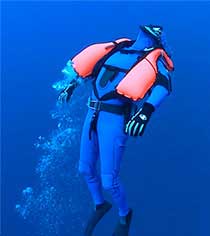New Life-Saving Gear for FreediversContents of this Issue: Rocio del Mar, Sea of Cortés, Mexico Scubapro Recalls Some Aladin Square Computers Wakatobi Dive Resort, Indonesia What Schwarzenegger Movie Title Fits the Lionfish Best? What to Do with Camera Batteries on Flights New Life-Saving Gear for Freedivers Does Diving Affect Your Hearing? Father and Son Divers Sue the Boat that Hit Them Editorial Office: Ben Davison Publisher and Editor Undercurrent 3020 Bridgeway, Suite 102 Sausalito, CA 94965 from the October, 2014 issue of Undercurrent
After almost a decade of toiling away in his workshop, veteran freediver Terry Maas, author of the definitive Blue Water Hunting and Freediving, has found a way to make freediving significantly safer. In March 2011, he debuted the Freedivers Recovery Vest, or FRV. The system contains an inflatable vest and a handheld programmable computer that constantly monitors a diver's depth and time underwater. If the computer senses that the diver has stayed submerged for too long or has dived too deep, it triggers two carbon dioxide cartridges to fill the emergency buoyancy vest, which flips a diver onto his back and brings him safely back to the surface. Maas is now selling his streamlined second version, the FRV Mark II to the public. Maas, age 69, is a California real-estate mogul with a private plane and a 32-foot catamaran. But he's also a top spearfisherman who has had his share of close calls in blackouts while freediving. Then, seven years ago, a friend who had lost a buddy to a blackout, called Maas, suggesting a life vest for freedivers be developed. "He thought we could do something with a dead-man switch which, when released, would inflate the vest," Maas says. "The problem, I told him, was most divers receive no advance warning they are going to black out, and furthermore, their hand might spasm closed over the switch preventing it from operating. We agreed that an automatic system would be better." Maas started an Internet forum with the idea of collaborating on plans for a simple timed device--stay down too long and the vest inflates. But one contributor pointed out that a diver might easily sink too deep before their time setting was reached. The vest needed a depth maximum as well. Further into his research, Maas realized many freedive accidents occur at the end of the dive, almost immediately upon surfacing. He needed a method for confirming the diver was conscious on the surface. The FRV's "Surface Minder" option makes the diver confirm that by pressing the button on the remote communicator light 15 seconds after arriving on the surface. If the diver is okay, the light extinguishes and the diver is free for another dive. Failure to push the button causes the vest to inflate and to quickly flip the diver onto his back.
The FRV Mark II is for sale -- at a hefty $1,500 -- on Maas's website ( http:/www.oceanicss.com ). "The Mark II is a sophisticated tool that can be very useful to those who regularly do breathhold diving," says Maas. "But for scuba divers, I'd recommend taking some freediving classes before purchasing this." |

I want to get all the stories! Tell me how I can become an Undercurrent Online Member and get online access to all the articles of Undercurrent as well as thousands of first hand reports on dive operations world-wide
| Home | Online Members Area | My Account |
Login
|
Join
|
| Travel Index |
Dive Resort & Liveaboard Reviews
|
Featured Reports
|
Recent
Issues
|
Back Issues
|
|
Dive Gear
Index
|
Health/Safety Index
|
Environment & Misc.
Index
|
Seasonal Planner
|
Blogs
|
Free Articles
|
Book Picks
|
News
|
|
Special Offers
|
RSS
|
FAQ
|
About Us
|
Contact Us
|
Links
|
3020 Bridgeway, Ste 102, Sausalito, Ca 94965
All rights reserved.

 When the U.S Navy Seals showed interest, Maas redesigned the FRV
into the Mark II model, which uses carbon dioxide cylinders, reducing the
weight and size by two-thirds and not interfering with a diver's weight belt.
The actuator that fills the bladder provides sufficient volume at any depth
the diver chooses (up to 330 feet). The actuator is tucked away on the diver's
back, and one communicates via a small lighted-button module worn on the
bicep. The bright light indicates when a dive has ended, and it blinks when
the button needs to be pressed. The remote connects with a short wire running
back to the vest near the armpit.
When the U.S Navy Seals showed interest, Maas redesigned the FRV
into the Mark II model, which uses carbon dioxide cylinders, reducing the
weight and size by two-thirds and not interfering with a diver's weight belt.
The actuator that fills the bladder provides sufficient volume at any depth
the diver chooses (up to 330 feet). The actuator is tucked away on the diver's
back, and one communicates via a small lighted-button module worn on the
bicep. The bright light indicates when a dive has ended, and it blinks when
the button needs to be pressed. The remote connects with a short wire running
back to the vest near the armpit.